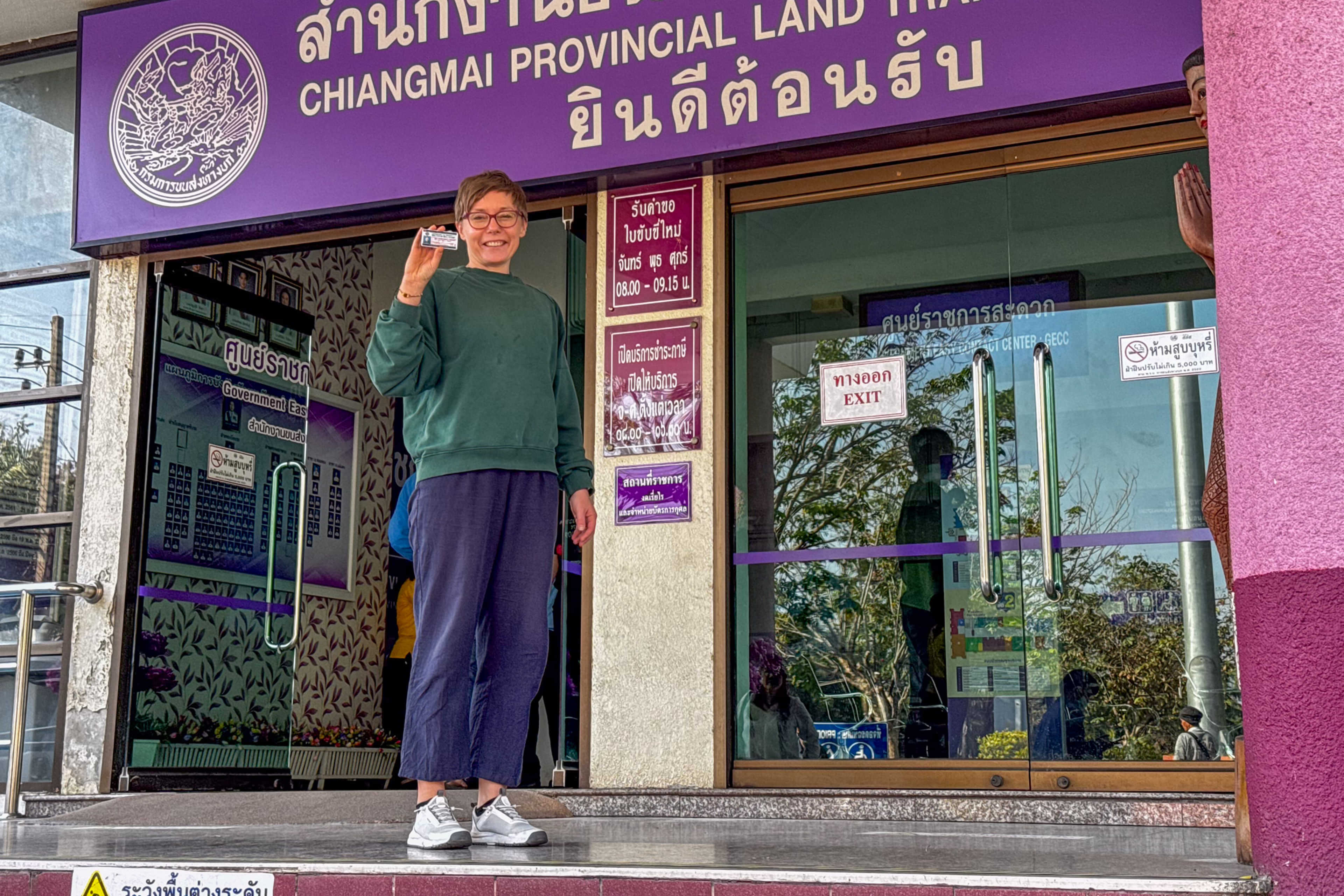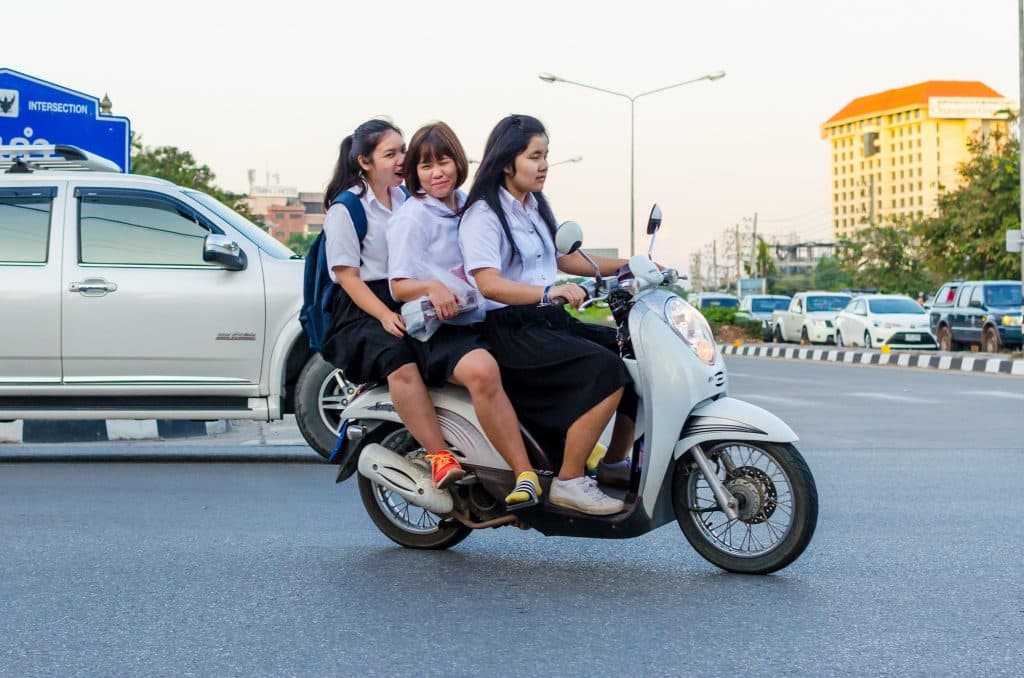
Live abroad
How to get a Thai driver’s licence in Thailand?
Destinations
Joanna Horanin
Hi, I'm Joanna, the author of The Blond Travels. In the worlds of Thailand and Portugal, I feel like a fish in water - and it's no coincidence! I've been exploring Thailand for over a decade, and I've settled in Portugal for 6 years now. My mission is to support Dreamers - just like you - in discovering these fascinating countries and helping those in love with them find their own place on Earth, preferably for good! Let's uncover these unique corners of the world together.
Some time ago I passed my Thai driving license. I had been putting it off for many years. I could have done it when I moved here more than a decade ago, but somehow I didn’t seem to have the strength or energy to do it. Encouraged by a friend who did hers in a few days, I also decided to act. I came again on a workation to Chiang Mai and set about getting the paperwork done. In this article, I’ll tell you how I got my driver’s license in Thailand and how you can do it too.
I understand that dealing with paperwork in a country like Thailand can seem a bit overwhelming to you. It’s a different culture, a different language, and sometimes the requirements at the offices can make no sense. I, too, thought that getting a license here would be a terribly long procedure. That’s probably also why I kept putting it off so much. Don’t worry. It’s not that complicated. It can also turn out to be a super adventure. Perhaps this article will persuade you to get yourself this document and drive on Thai roads safely and legally.
Why is it worth having a Thai driver’s licence in Thailand?
In order to legally drive a scooter in Thailand, you must have a category A driver’s license, and an international driver’s license.
For me personally, there were three reasons for getting my license in Thailand – I no longer have to get an international driver’s license every year, I can avoid fines, and I’m also confident that in case of an accident my insurance will cover my medical expenses.

Additional benefits of having a Thai driver’s license is that you get always better rates when renting a car, and for admissions to national parks and other attractions, you pay Thai rates, which are much lower. Here I will point out that this is not always necessarily the case, because, for example, to Doi Inthanon even with this document you pay the price for foreigners, but in many other places you will pay less.

Explore your next holiday destination at your own pace with a rental car. Hit the open road and discover hidden gems and off-the-beaten-path destinations. Rent a car with Discover Cars at the best market rates!
What documents will you need?
Despite what you might think, you don’t need a whole bunch of documents. All you must have are:
TM 30 – you will receive it from your landlord or from the reception desk at the hotel. You must make sure that the address on this document will be your mailing address for the duration of the course and the exam.
Passport photo
- A copy of the photo page from your passport and visa. If you don’t have a visa, this can be the stamp you get at the airport. – In Chiang Mai, you’ll get a copy and photo at the back of the immigration building. You get everything on hand.
- Residency certificate – you make one at the emigration office. I used to get them made in Chiang Mai. The filing station is located on the 2nd floor. There you submit TM30, a photo and copies of your passport and visa. The certificate normally comes by mail in 2-3 weeks to the address you provide on the TM30, but you can ask for expedited mode, which costs THB 1,000 per person.
- Certificate from the school about passing the exams – you get it at the end after the course, but with the above documents you can go to the driving school and already enroll in the course.
- Health certificate – you can get it at the hospital. I went to RAM Hospital in Chiang Mai, where I always take my exams. The cost of the short exam is 170 THB per person and is done on the spot, without an appointment.
My experiences – Getting all the documents
As soon as I arrived in Chiang Mai, I asked my landlord for a TM30, which I got the same day. I printed everything out and went to the immigration office with it. I’m somewhat familiar with the Chiang Mai office, because this is where I extended my work visas when I was still teaching school, but I didn’t know that the whole building had grown so much. It used to be a tiny one-story building. Now it has a couple of floors and you can get a lot done here.

Knowing from previous articles on the Internet, I first went behind the main office to take photos and copy my passport. This took 10 minutes. For a few hundred Baht, I got the photos and documents right away. With that, I went to the second floor of the main office, where a two-person booth was set up in the hallway. Young, sympathetic girls took my papers and announced that I would receive my residency certificate in three weeks. I gently asked if it couldn’t be faster. I paid THB 1,000 for the express service. Immediately after that, I went to a school that a friend recommended to me. SafeDrive Chiang Mai School is located near the airport, on the road leading to Hang Dong. It is a small office that doesn’t seem to have a lot of customers. The nice lady at the front desk made a copy of my passport, charged me 2,000 THB and signed me up for the course, which was due the following weekend.
The next day I picked up my residency certificate. From the immigration office, I went to RAM Hospital. It is a large hospital with two main buildings. One admits patients to specialists and for unexpected illnesses. The other building is the so-called test center, where tests and checkups are performed. That’s where, without making an appointment, I went in and had the necessary tests done in half an hour. I paid 170 THB. At the end I received a health certificate nicely wrapped in an envelope.

Luma offers a wide range of health care plans suitable for both expats and Thai nationals residing in Thailand. Benefits such as lifetime renewal guarantee and full cover for cancer, both in- and out-patient are just some of the features. Get your quote
All was left to do was to do my driving licence.
The driving course in Thailand – How did it go?
On Saturday morning I had to show up for my ride at the training center in Mae Rim. It is a small village and district near Chiang Mai. The school was housed in a low, white building. In front of it, two old dogs lounged and chickens with little chicks ran around. Right next door, in the training yard stood cars and scooters for test drives. I might add here that I came to this course with my scooter. The instructor asked me if I had been riding for a long time and when I said about 10 years, he didn’t even blink. He didn’t know I had a European motorcycle license and didn’t ask. No one in Thailand is surprised that you drive without a license.

I spent 6 hours at the school – from 8 a.m. to about 2 p.m. We were divided into 2 groups – in one there were 3 people from Thailand, in the other there was me, my husband and another foreigner. Everything for us was in English. We rode around the plaza a few times throughout. The rides consisted of going around the square a couple of times along a designated route. The instructor paid attention to using turn signals, stopping at a stop sign and driving smoothly. For me, the most difficult part was driving very slowly, without backing up on the yellow straight line. The task seems trivial, but it took me a very long time to finally complete it.
Once we drove outside the school, onto the road and went around the village all the way. It was an extremely pleasant ride among the rice fields, temples and local life. While driving, it was impossible not to smile. Such a course is sheer pleasure. Our instructor led our little procession. We had to do what he did all the time. He paid attention to turn signals and the general smoothness of driving. It may sound very formal, but frankly everything was done in a very relaxed manner and there was no need to stress at all.

At about 1:30 pm we took the exam, which consisted of driving around the square on the designated route. I made a mistake once and had to repeat one section, but overall it went very well and of course I had everything passed.
If you are going to pass your driving license in Thailand, I recommend taking a book or something to keep you occupied for a long time. The entire practical course, as well as the theoretical course, which I will tell you about in a moment, consists of a couple of hours of waiting. Very long breaks are taken to enter the fingerprint into the system. It has to be done roughly every hour until 2 p.m. Then there is an exam, and then a break until 5 p.m. Here, too, I recommend that you come with your transportation, because there is literally nothing in the area where you can go. You have to go to a restaurant or coffee. We went for delicious food, which I highly recommend, and to Akha Ama, where coffee is prepared for the famous coffee shops in Chiang Mai.
At 5pm we returned only to be imprinted again and entered into the system. Immediately after that we were free.
The second day was a theoretical day. We had to show up before 8 at the school in Chiang Mai. In our group there were 3 of us foreigners and one girl from Thailand. We were seated in a classroom, given sample tests – for us in English, for her in Thai, and played a film in Thai that lasted 3 hours. A couple of times we were again asked for a fingerprint. After a lunch break, we watched the movie again, this time it lasted an hour and there were subtitles in English. The content was mainly about road safety.

After the film screening was over, we were moved to another room, where prepared laptops with the exam were waiting for us. I’ll honestly say that the questions surprised me a little, because only some of them were on the recording and in the tests. There were also some where you didn’t quite know which answer was correct, because they all seemed logical or none were correct. Fortunately, the examiner helped us get through the more difficult ones, for which we were not prepared.
After the theoretical exam, we received the document and were told to go to the Land and Transportation Office the next morning.
Picking up my driving licence
We went to branch number 2 of the Land and Transportation Office early in the morning, before everything was even open. However, we were allowed into the building and asked to sit in the waiting room. After 8 o’clock, the room began to fill up with petitioners. At 8:30, officials opened the windows.
Foreigners in this particular office, must submit all ready documents at window number 27. They must be left on a special tray along with the passport and wait to be called. For everything to run neatly and quickly you need to have with you:
- Passport and a copy of the photo page
- Visa or stamp in passport and a copy of that page or visa
- Health certificate
- Certificate of residency
- Certificate of passing the exams
- 150 THB in cash
When I was called to the window, I was given my documents and assigned a number. I had to sign all the pages in the document and check that everything was written correctly. I was also asked to sit down and wait for the number to be called.
As I sat and waited, a little out of boredom, I started reading the Thai text on my driver’s license application. I’m not that fluent in reading, but I can read a short text, especially when I know the context. Three years of Thai were not in vain, because I noticed that under nationality they had entered Germany, not Poland, for me. I ran immediately to the window for a correction.
When my number was finally called, I made a payment of 150 THB, then was directed onward to take a photo. At the small counters, labeled 1 through 5, the clerks took the photos quickly, uploaded them to the computer, and then after literally 5 minutes a new, warm driver’s license popped out of a special printer! The whole thing took about 2 hours. It is worth coming here before the opening. After that, it gets crowded and you wait a long time for your turn.

The whole process was a bit tiring, I’ll admit frankly. A lot of things were a bit pointless and seemed like a slight waste of time. Just waiting to be fingerprinted every hour was strange, but well – that’s Thailand. You have to get over your own. The most important thing is that now I have a driver’s license and can drive without too much trouble.
I highly recommend getting a Thai license if you live in Thailand, want to live in Thailand, or come here regularly for vacation or workation. It is a very convenient option and really gives you a lot of benefits. It will help you avoid fines, save you problems and you won’t have to worry about whether your insurance will cover you in case of an accident. Getting a driver’s license in Thailand is easy and doesn’t cost much. I’m keeping my fingers crossed for you! Good luck!
How to drive safely on the roads in Thailand?
To legally ride a scooter in Thailand, you must have a Category A driver’s license and an international driver’s license if you do not have a Thai document. Having these documents will ensure that you will receive assistance from your insurer in case of an accident.
Your travel insurance to Thailand should cover scooter riding. I recommend you get Genki or SafetyWing, which have just such options. Luma Travel Insurance also has good policies for scooter drivers. This one is better, if you live in South East Asia. If you have the right documents, you don’t have to worry about anything.

Travel and travel medical insurance for nomdas and long-term travellers. Buy it anywhere, everywhere and enjoy a peace of mind.
Always wear a helmet. In rental shops they will certainly give you something that is not the sturdiest or most durable, but better to than nothing. If you’re staying in Thailand longer, it’s worth buying something better. Always have a helmet on and well fastened when riding. There is a fine for not wearing a helmet.
Don’t drive under the influence of alcohol or other substances. This is sometimes forgotten in Thailand, but it’s really not worth the risk. Driving under the influence can result in imprisonment and a hefty fine. In addition, insurance will not cover medical expenses if something happens to you or others.
In Thailand, we drive on the left side of the road. This is not as difficult as it seems. You just have to remember that, for example, when entering the main road, we must look first to the right, then to the left. Scooters in Thailand should always drive in the farthest left lane. You can, of course, overtake, but only if you are sure you can accelerate properly.
I think you should also forget what you know about traffic. Here drivers have their own idea of how things should be. I first observed how others drive and what they do while driving. For example, I learned from a friend of mine who drove me around town often that you should always look over your shoulder when turning.
The most common reason for accidents in Thailand is through driver’s sleeplessness or failure to turn on signals. A lot of people also drive fast at intersections at orange lights. Never trust others on the road and use a high degree of caution.
In case of an accident, wait for help and contact your insurance company.
I hope you have a beautiful time in Thailand and enjoy riding your scooter legally and safely.